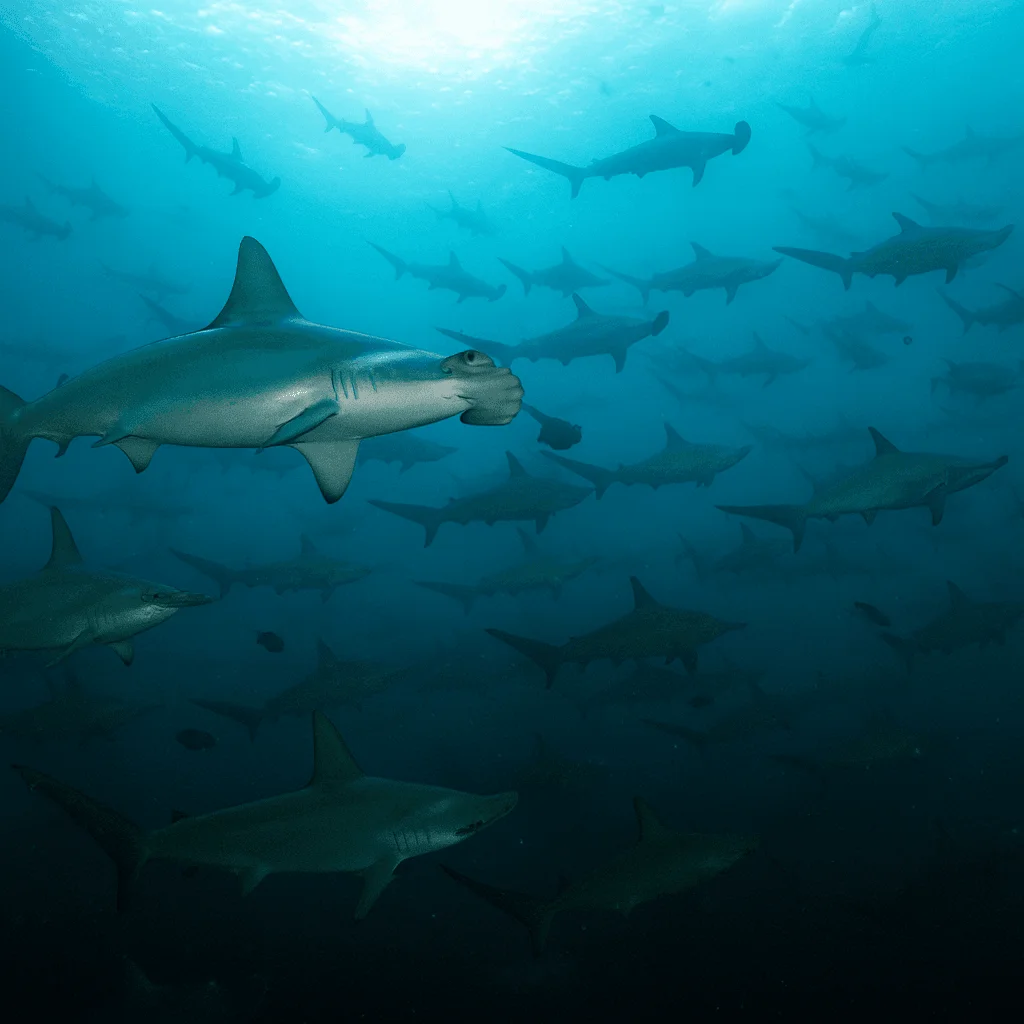Scuba Diving in Mikomoto
The Ultimate Guide
Mikomoto Island is a small, uninhabited rock off the southern tip of the Izu Peninsula. Lying at the confluence of the Pacific and the Kuroshio Current, it offers Japan’s wildest drift diving. Experienced divers come here to fin alongside schools of scalloped hammerhead sharks that ride the currents above sheer walls. The island’s underwater topography includes plateaus, pinnacles and drop‑offs draped in soft corals and sponges. Add in sightings of sandbar and blacktip sharks, tuna, amberjacks, eagle rays and trevallies and you have one of Asia’s premier big‑animal dives. Because of the strong currents and depths of 25–30 m, Mikomoto is strictly for advanced divers comfortable with negative entries, quick descents and deploying surface marker buoys.
Difficulty
Advanced
Temperature
16-27°C
Visibility
20-30m

Diving Highlights
Best Months to Dive
Getting to Mikomoto for Diving
✈️Transportation
To reach Mikomoto, fly into Tokyo and take the train or highway bus to Izukyū‑Shimoda on the Izu Peninsula (about three hours from Tokyo by train).
Dive operators based in Shimoda harbour provide gear, briefings and a short 15–20‑minute boat ride to the island.
Because of the intense currents and early departure times, divers usually stay overnight in Shimoda or in nearby onsen towns and join guided day trips.
Country
Japan
Currency
Japanese Yen
Electricity
100V, 50/60Hz, Type A/B plugs
Cost of a Dive Trip in Mikomoto
Day Trip
Meal
Accommodation
Best Dive Sites in Mikomoto
🐠Kame‑ne (A Point)
The signature site on Mikomoto’s south‑eastern tip, Kame‑ne is a plateau at 25–30 m where the Kuroshio Current hits the reef. This is the place to witness hundreds of scalloped hammerhead sharks cruising in formation overhead. Divers hook onto the rock and watch the ballet of sharks and trevallies in the blue. The currents can be fierce and require a quick negative entry.
🐢Mitsu‑ne (Three Rocks)
Three pinnacles rise from the seabed creating channels where currents funnel baitfish and attract predators. Tuna, amberjacks and even turtles swim between the rocks while hammerheads occasionally pass by. Coral and sponge‑encrusted walls add colour to the scene.
🦈Shira‑ne
This site features a white sand bottom at 20 m dotted with rocks and kelp beds. Divers may see Japanese bullhead sharks resting on the sand along with schools of butterflyfish and wrasse. The area is calmer and makes a good second dive.
🐙Zabu‑ne
Zabu‑ne sits on the exposed western side of Mikomoto. Enormous boulders create slots where the current accelerates, providing an exciting drift dive. Expect pelagics streaking by and wave action on the safety stop.
🐚Enokuchi
Located near the boat mooring, Enokuchi is more sheltered and used when conditions are too rough elsewhere. Coral gardens, nudibranchs and schools of fusiliers make it a pleasant macro and fish‑watching dive.
What Divers Say About Diving in Mikomoto
Earl Philip
Technical DiverMikomoto is as exhilarating as diving gets. After a negative entry you immediately feel the current pulling you like a river. Fin hard to reach the ridge and suddenly the blue fills with the silhouettes of hammerheads, dozens drifting past in formation. When the sharks vanish, eagle rays, yellowtail amberjacks and curious tuna glide by. Between dives you cling to the mooring line as the boat rocks in the swell and chat with other wide‑eyed divers about the incredible sighting. This is not a place for new divers – but if you’re experienced and crave big animals and adrenaline, Mikomoto will blow your mind.
Frequently Asked Questions About Diving in Mikomoto
When is the best time to see hammerheads at Mikomoto?
June through October offers the highest chance of large schools of hammerheads. In spring and autumn you may still see hammerheads but the water is cooler and conditions more variable.
What marine life can I expect?
Besides scalloped hammerhead sharks, divers often see sandbar sharks, blacktip reef sharks, tuna, amberjacks, trevallies, eagle rays and swirling schools of fusiliers. Macro life includes sea slugs and reef fish on the sheltered sites.
Is Mikomoto suitable for beginners?
No. All dives are drift dives with strong currents and negative entries. Operators require divers to have advanced certification, recent experience and to carry a surface marker buoy.
How many dive sites are around Mikomoto?
There are five main drop points: Kame‑ne (A Point) for hammerhead action, Mitsu‑ne (Three Rocks) with channels and tuna, Shira‑ne with sandy slopes and bullhead sharks, Zabu‑ne for rapid drifts and wave‑washed boulders, and Enokuchi, a more sheltered site used when conditions are rough.
What gear should I bring?
A 5 mm wetsuit or semidry suit with hood is advised in spring/autumn and a 3–5 mm in summer. Bring a surface marker buoy, reef hook and gloves to hold onto rocks. Dive computers and good buoyancy control are essential.
Are there accommodations on Mikomoto itself?
No. Mikomoto is uninhabited. Divers stay in Shimoda or Minami‑Izu and join day boats that depart early in the morning.